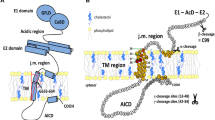Abstract
The lipid components of the senile plaque (SP) remain largely unknown. Senile plaques were said to be enriched in cholesterol in a few studies using the cholesterol probe filipin and a histoenzymatic method based upon cholesterol oxidase activity. We provide data that strongly suggest that these results are false-positive: the SPs were still stained in the absence of the enzyme cholesterol oxidase; filipin still labeled the plaques after lipid extraction. On the other hand, resorufin, the highly fluorescent end-product of the histoenzymatic method, bound with high affinity to the SPs and neurofibrillary tangles in a cholesterol-independent manner, and might serve as a new marker of amyloid. In conclusion, the probable cholesterol enrichment of the SPs has never been proven so far, and might necessitate non-histological methods to be ascertained.

Similar content being viewed by others
References
Adams C, Bayliss O (1975) Lipid Histochemistry. In: Glick D, Rosenbaum R (eds) Techniques of biochemical and biophysical morphology. Wiley, New York, pp 100–156
Black SL, Stanley WA, Filipp FV et al (2008) Probing lipid- and drug-binding domains with fluorescent dyes. Bioorg Med Chem 16:1162–1173
Burns MP, Noble WJ, Olm V et al (2003) Co-localization of cholesterol, apolipoprotein E and fibrillar Abeta in amyloid plaques. Brain Res Mol Brain Res 110:119–125
Deraeve C, Pitie M, Meunier B (2006) Influence of chelators and iron ions on the production and degradation of H2O2 by beta-amyloid–copper complexes. J Inorg Biochem 100:2117–2126
Dietschy JM, Turley SD (2001) Cholesterol metabolism in the brain. Curr Opin Lipidol 12:105–112
Liao L, Cheng D, Wang J et al (2004) Proteomic characterization of postmortem amyloid plaques isolated by laser capture microdissection. J Biol Chem 279:37061–37068
Masliah E, Mallory M, Deerinck T et al (1993) Re-evaluation of the structural organization of neuritic plaques in Alzheimer’s disease. J Neuropathol Exp Neurol 52:619–632
Mori T, Paris D, Town T et al (2001) Cholesterol accumulates in senile plaques of Alzheimer disease patients and in transgenic APP(SW) mice. J Neuropathol Exp Neurol 60:778–785
Opazo C, Huang X, Cherny RA et al (2002) Metalloenzyme-like activity of Alzheimer’s disease beta-amyloid. Cu-dependent catalytic conversion of dopamine, cholesterol, and biological reducing agents to neurotoxic H2O2. J Biol Chem 277:40302–40308
Puglielli L, Friedlich AL, Setchell KD et al (2005) Alzheimer disease beta-amyloid activity mimics cholesterol oxidase. J Clin Invest 115:2556–2563
Simons M, Keller P, De Strooper B et al (1998) Cholesterol depletion inhibits the generation of beta-amyloid in hippocampal neurons. Proc Natl Acad Sci USA 95:6460–6464
Strittmatter WJ, Saunders AM, Schmechel D et al (1993) Apolipoprotein E: high-avidity binding to beta-amyloid and increased frequency of type 4 allele in late-onset familial Alzheimer disease. Proc Natl Acad Sci USA 90:1977–1981
Tanzi RE, Bertram L (2001) New frontiers in Alzheimer’s disease genetics. Neuron 32:181–184
Thal DR, Ghebremedhin E, Haass C, Schultz C (2002) UV light-induced autofluorescence of full-length Abeta-protein deposits in the human brain. Clin Neuropathol 21:35–40
von Braunmühl A (1957) Alterserkrankungen des Zentralnervensystems. Senile Involution. Senile Demenz. Alzheimersche Krankheit. In: Lubarsch O, Henke F, Rössle R (eds) Handbuch der speziellen pathologischen Anatomie und Histologie. Springer, Berlin, pp 337–539
Author information
Authors and Affiliations
Corresponding author
Rights and permissions
About this article
Cite this article
Lebouvier, T., Perruchini, C., Panchal, M. et al. Cholesterol in the senile plaque: often mentioned, never seen. Acta Neuropathol 117, 31–34 (2009). https://doi.org/10.1007/s00401-008-0448-1
Received:
Revised:
Accepted:
Published:
Issue Date:
DOI: https://doi.org/10.1007/s00401-008-0448-1




